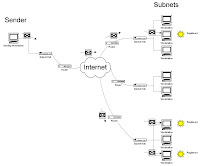Their are three major categories of wireless network.
 WPAN--Is the smallest wireless network used to connect various peripheral devices. Mice, keyboards, and PDAs use WPAN. All these devices are dedicated to a single host and usually use IR or Bluetooth technology. IR is electromagnetic waves with a frequency range above that of microwaves, but below that of the visible spectrum. Bluetooth is wireless industy standard that uses an unlicensed radio frequency for short-range communication enabling portable devices to
WPAN--Is the smallest wireless network used to connect various peripheral devices. Mice, keyboards, and PDAs use WPAN. All these devices are dedicated to a single host and usually use IR or Bluetooth technology. IR is electromagnetic waves with a frequency range above that of microwaves, but below that of the visible spectrum. Bluetooth is wireless industy standard that uses an unlicensed radio frequency for short-range communication enabling portable devices tocommunicate over short distances.
 WLAN-- Is typically used to extend the boundaries of the local wired network. Use RF technology and conform to the various IEEE 802.11 standards. Allow many users to connect to a wired network through a device known as an access point. Access point acts as a connection between the wireless network and the Ethernet wired network.RF is radio frequency which means electromagnetic waves generated by AC and sent to an antenna within the electromagnetic spectrum. Their are four types of IEEE 802.11 standards: 802.11a, 802.11b, 802.11g and 802.11 n.
WLAN-- Is typically used to extend the boundaries of the local wired network. Use RF technology and conform to the various IEEE 802.11 standards. Allow many users to connect to a wired network through a device known as an access point. Access point acts as a connection between the wireless network and the Ethernet wired network.RF is radio frequency which means electromagnetic waves generated by AC and sent to an antenna within the electromagnetic spectrum. Their are four types of IEEE 802.11 standards: 802.11a, 802.11b, 802.11g and 802.11 n. WWAN-- Is coverage over extremely large areas. An example of WWAN is the cell phone network. WWAN is often regulated by government agencies that use technologies like, code division multiple access and global system for mobile communication. CDMA is a communication channel access method that uses spread-spectrum technology and a special coding scheme. GMS is an international standard for cell phones.
WWAN-- Is coverage over extremely large areas. An example of WWAN is the cell phone network. WWAN is often regulated by government agencies that use technologies like, code division multiple access and global system for mobile communication. CDMA is a communication channel access method that uses spread-spectrum technology and a special coding scheme. GMS is an international standard for cell phones.Despite these distinct categories, placing boundary limitations on a wireless network is difficult. Because unlike a wired network, a wireless network does not have precisely defined boundaries. The range of wireless transmissions can vary due to many factors. The range of wireless networks can be affected by natural and man-made interference, fluctuation in environmental conditions, as well as the composition and placement of obstacles within the wireless coverage area.










